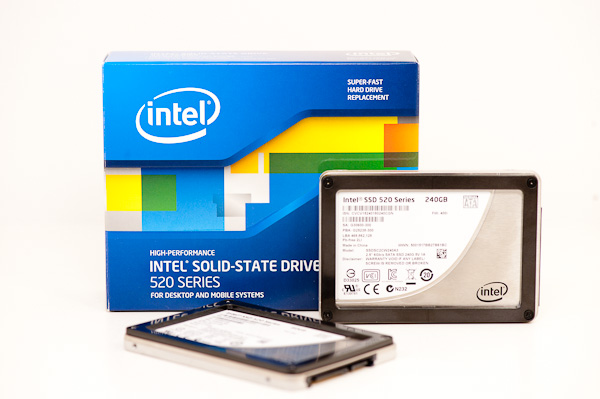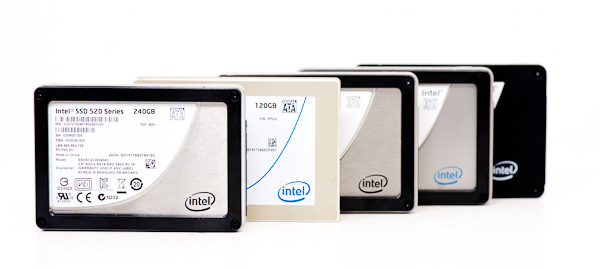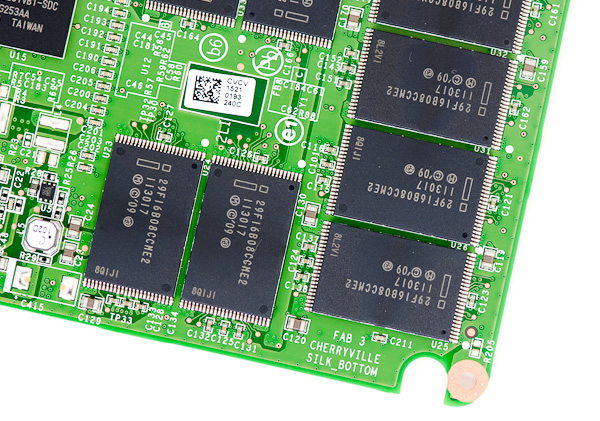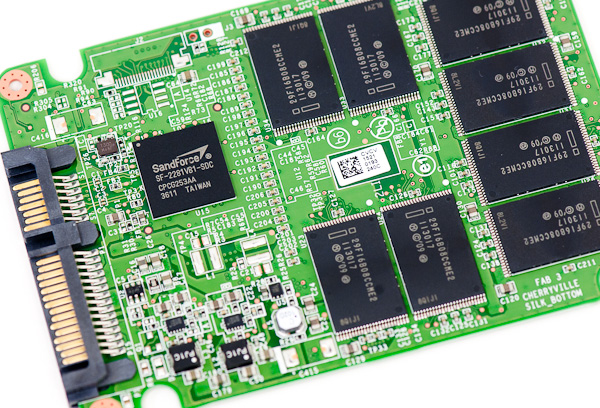Intel SSD 520 Review: Cherryville Brings Reliability to SandForce
by Anand Lal Shimpi on February 6, 2012 11:00 AM ESTIntel was rumored to be working on a SandForce based drive for several months now, but even the rumors couldn't encapsulate just how long Intel and SF has worked on this drive. According to Intel, the relationship began 1.5 years ago. Still lacking a 6Gbps controller of their own and wanting to remain competitive with the rest of the market, Intel approached SandForce about building a drive based on the (at the time) unreleased SF-2281 controller. Roughly six months later, initial testing and validation began on the drive. That's right, around the time that OCZ was previewing the first Vertex 3 Pro, Intel was just beginning its extensive validation process.
Codenamed Cherryville, Intel's SSD 520 would go through a full year of validation before Intel would sign off on the drive for release. In fact, it was some unresolved issues that cropped up during Intel's validation that pushed Cherryville back from the late 2011 release to today.
Intel's strenuous validation will eventually make SandForce's drives better for everyone, but for now the Cherryville firmware remains exclusive. Intel wouldn't go on record with details of its arrangement with SandForce, but from what I've managed to piece together the Intel Cherryville firmware is exclusive for a limited period of time. That exclusivity agreement likely expires sometime after the SF-2281 is replaced by a 3rd generation controller. There are some loopholes that allow SandForce to port bug fixes to general partner firmware but the specific terms aren't public information. The important takeaway is anything fixed in Intel's firmware isn't necessarily going to be fixed in other SF-2281 based drives in the near term. This is an important distinction because although Cherryville performs very similarly to other SF-2281 drives, it should be more reliable.
As Intel has been working on this firmware for quite a while, it's likely that the 520 uses an older branch of the SF-2281 firmware that has been updated over the past twelve months.
The BSOD is Back, but Not on Intel
Back in October SandForce announced that it had discovered a firmware issue that resulted in unexpected BSODs on SF-2281 drives on certain platforms. Why it took SandForce several months to discover the bug that its customers had been reporting for a while is a separate issue entirely. SandForce quickly pushed out the firmware to OCZ and other partners. Our own internal testing revealed that the updated firmware seemed to have cured the infamous BSOD.
Just as background, our SSD testing is rarely over once the review goes live. Any drive we recommend gets tossed into a primary use machine somewhere within the company. We keep track of drive behavior, including any bugs or performance issues over time. This long term testing process takes place over months. The results of these long term tests are folded into future reviews and recommendations.
The BSOD is caused by a bug in SandForce's power state logic that ultimately results in the drive disconnecting from the system while it's running. It turns out that Windows isn't a fan of you hot un-plugging the drive it's running on, which results in the BSOD. We had two systems that exhibited the BSOD, both of which were fixed by the update last October.

As luck would have it, our own Brian Klug happened to come across an unexpected crash with his 240GB non-Intel SF-2281 based SSD two weeks ago when he migrated it to another machine. The crash was an F4 BSOD, similar in nature to the infamous BSOD issue from last year. While two of the systems we reproduced the BSOD bug on were cured by last year's firmware update, Brian's system (an X58/Core i7 build) was BSODing regularly playing Battlefield 3. Games end up being a great way to trigger the SF-2281 BSOD issue as they frequently switch between periods of idle and load, which does a good job of stressing the power state logic in SandForce's firmware. I immediately sent Brian an Intel SSD 520 to see if the BSOD remained on Intel's drive. Switching to Cherryville caused Brian's BSODs to go away. Indeed most end user reports of SF-2281 BSODs went away with the fixed firmware, but we've still heard of isolated issues that remain unresolved. Whatever Intel has done with the 520's firmware seems to have fixed problems that still remain in the general SF-2281 firmware.
This is actually a dangerous precedent as it means one of two things. The first possibility is that SandForce has been made aware of flaws in its current firmware and chooses against (or is legally prevented from) disclosing it to its partners. The second possibility, and arguably even worse for SandForce, is that Intel was able to identify and fix a bug in the SF-2281 firmware without SandForce knowing it existed or was addressed. I suspect it's the former but as no one is willing to go on the record about the Intel/SandForce agreement I can't be certain.
Intel did go on record saying that the 520 is expected to have far fewer F4/F7 BSODs than any other SF-2281 drive. I asked Intel if I should read into the phrase "far fewer", but the answer was no - the 520 is expected to have similar reliability to the Intel SSD 510 and 320.
At the end of the day that's what Intel really brings to the table with the 520. As you'll soon see, performance isn't very different compared to other SF-2281 based drives. Intel's biggest advantage comes from the unique firmware that ships with the drive. Intel is also quick to point out that while other SF-2281 manufacturers can purchase the same Intel 25nm MLC NAND used on the 520, only Intel's drives get the absolute highest quality bins and only Intel knows how best to manage/interact with the NAND on a firmware level. While it's nearly impossible to prove most of this, the fact that we're still able to reproduce a BSOD on the latest publicly available SF-2281 firmware but not on the SF-2281 based Intel SSD 520 does say a lot about what you're paying for with this drive.
And you are paying a premium for the 520 compared to other SF-2281 based SSDs on the market today:
| Intel SSD 520 Price Comparison | |||||||
| 60GB | 120GB | 180GB | 240GB | 480GB | |||
| Intel SSD 520 (SF-2281) | $149 | $229 | $369 | $509 | $999 | ||
| Kingston HyperX (SF-2281) | N/A | $205 | N/A | $420 | N/A | ||
| OCZ Vertex 3 (SF-2281) | $95 | $190 | $240 | $375 | $850 | ||
| Samsung SSD 830 | $110 | $220 | N/A | $360 | $800 | ||
Last year Intel hinted at a move from the consumer market to enterprise server and client markets. The 520's higher price likely won't matter there, but for consumers the higher price is noticeable - particularly with good options from companies like Samsung now available on the market.














138 Comments
View All Comments
hugh2323 - Monday, February 6, 2012 - link
Some posters are missing the reason why this drive has a high premium. It is intented for the market that values reliability over price. This market considers the price of lost data to be higher than the premium of the drive. If you are a business, and a computer goes down with its data, the lost hours of productivity and cost of data loss can easily add up. Compared to paying 20% extra for the drive initially (or whatever it is), is chump change compared to that.And then there is the consumer market that doesn't have time to f*** around with blue screen of death and whose purse strings perhaps aren't so tight.
So if you don't want to pay the premium, then your not in the target market. Simple as that.
neotiger - Monday, February 6, 2012 - link
... except this SSD doesn't give you reliability.It doesn't have any capacitors, which means after a computer crash or a power outage you will lose your data.
Not exactly reliable.
eman17j - Wednesday, February 8, 2012 - link
ssd are nonvolatile memory how are you going to lose all your data?eman17j - Wednesday, February 8, 2012 - link
oops I spoke to soon I know what you mean it wouldnt have the power to finish any write operation if there was an crash or power outage thereby losing your databji - Wednesday, February 8, 2012 - link
Irrelevant. Any application can make a sync call to ensure the data is written to the flash as necessary. Any application which does not make this sync call is risking the data at multiple levels of write cache before it actually makes it to the flash, so a capacitor would reduce the window of opportunity for data loss only slightly. And if you care that much about data loss, you are using sync anyway at that point of the application.eman17j - Wednesday, February 8, 2012 - link
buy an upsJediron - Tuesday, February 7, 2012 - link
Since when are MLC based SSD's more reliabele then SLC based SSD's ?Sorry, if they intended to put these SSD's in the market for endurance and reliability they make a mistake.
FunBunny2 - Tuesday, February 7, 2012 - link
bingo. but they last used SLC in the X25-E, and even Texas Memory is switching to MLC. The vendors are convinced they can get through warranty period with MLC. Unlike a HDD, which can last pretty much forever if it makes it through infant mortality, an SSD will die when it's time is up (think "Blade Runner").bji - Wednesday, February 8, 2012 - link
Theoretically, the failure mode for completely worn out flash should be that the drive can no longer be written to, but every existing block can still be read from. Thus you would not lose any data, you'd simply have to buy a new drive and clone the old one to it.In practice, it seems like either most SSD failures are not in the flash (maybe they are the result of firmware bugs that wedge the on-disk structures into an unrecoverable state?), or that if they are in the flash most firmware do not handle such failures gracefully and instead of putting the device into a read-only recoverable mode just give up and die. This is after reading many, many reports of SSD failures where the device became completely inoperable instead of going into read-only mode.
Also I've had plenty of platter HDD failures over the years, I always found them to be the least reliable component of any computer (ok, I guess fans are less reliable, but fan failure usually isn't catostrophic and is easy to fix; also power supplies die pretty frequently and finally for some reason CD/DVD drives also seem to fail disturbingly often).
beginner99 - Tuesday, February 7, 2012 - link
I disagree. It is too late to the market. the crucial m4 has proven its reliability in the real world and the intel drive has no special reliability features. And IMHO real world usage beats any validation tests intel can do.If you value your data you would have to back it up anyway, regardless of which drive you use.
m4: never heard of BSOD issues.
While I agree that sandforce drives have issues, there are others that do not and are also cheaper. The m4 is way best value. It's similar to CPUs. It is basically impossible to recommend any Desktop AMD CPU in any price or performance category. Same for SSD but here it is not possible to recommend Intel anymore.Neither for price, performance or reliability.